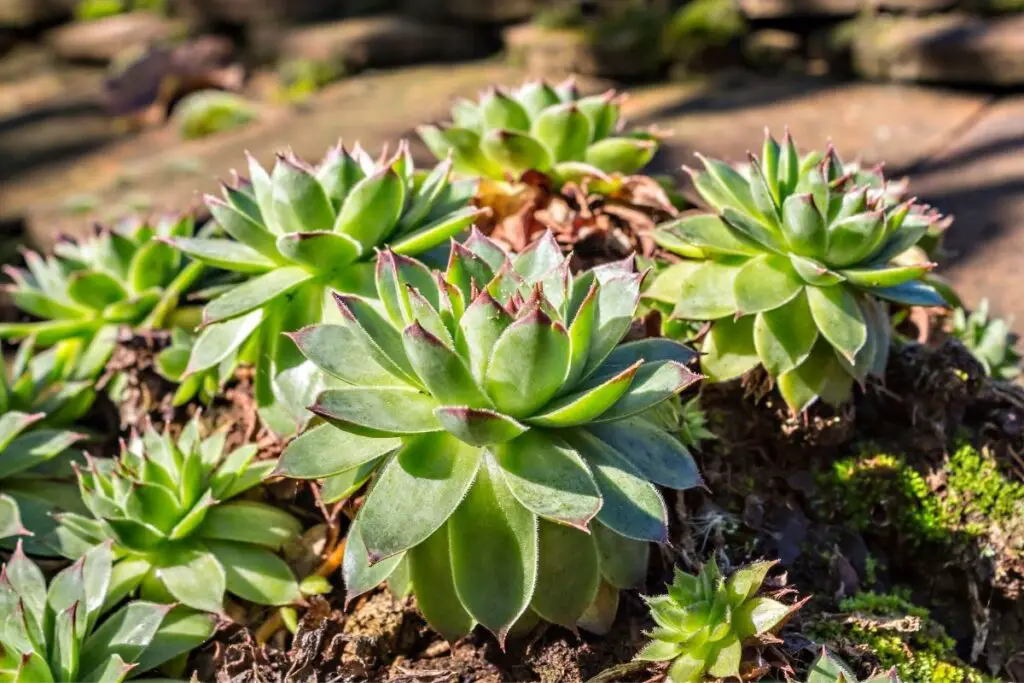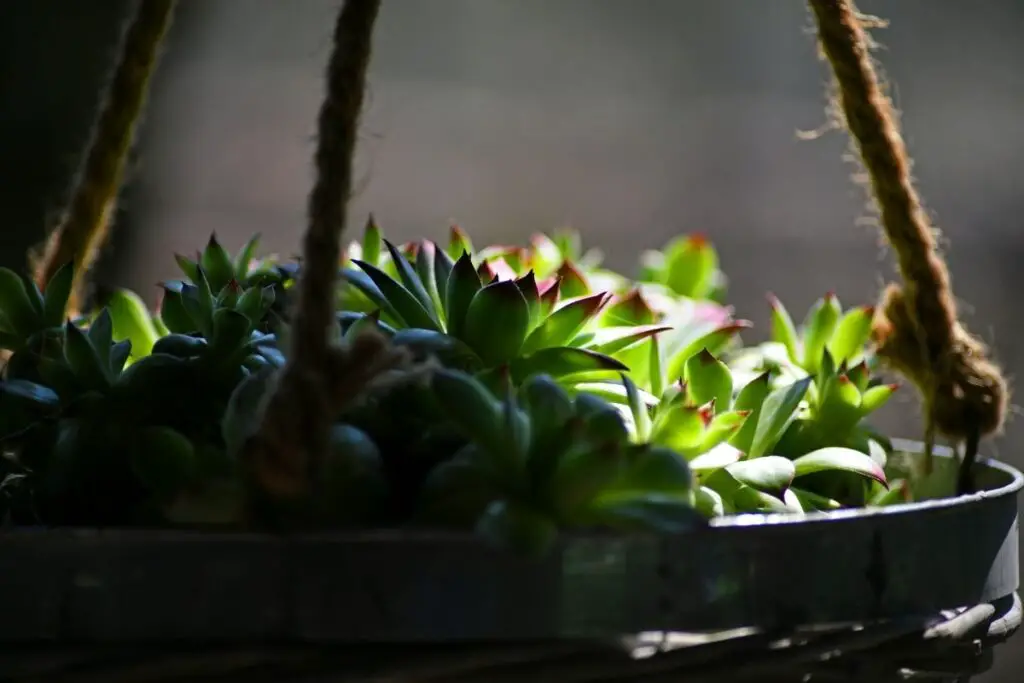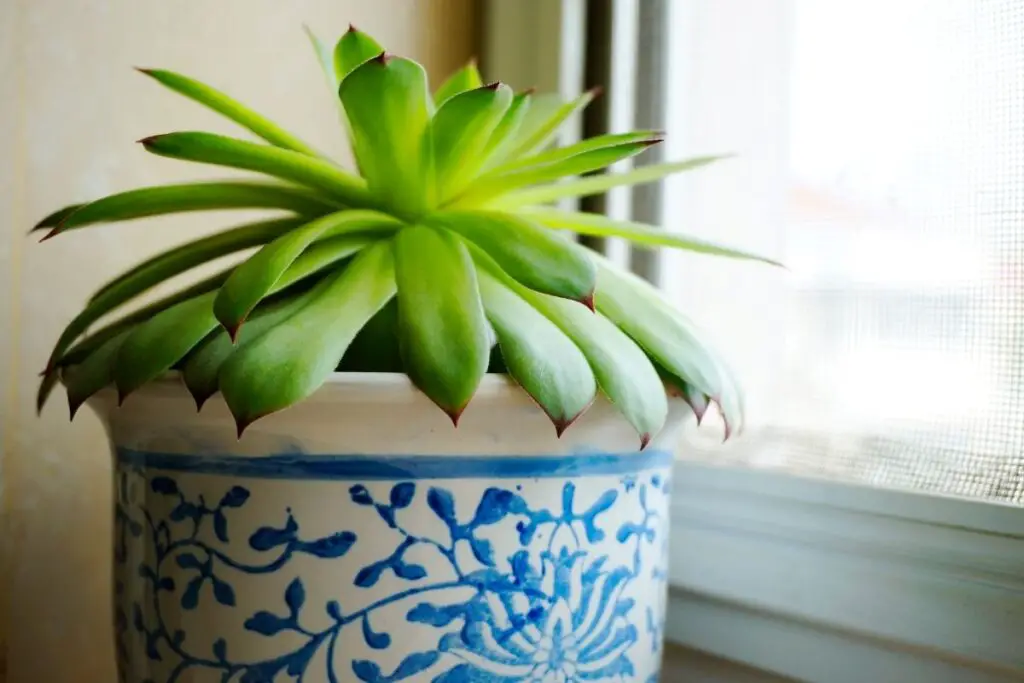Hens and chicks fall in the Sempervivum group of succulents. They are also known as Houseleeks and Hen widdies. Like most succulents, they need a lot of sunlight but how much light would be ideal for them?
In this article, we shall understand the light requirements of hens and chicks plants. So, let’s get right into it.
In general, Hens and Chicks require 6-8 hours of full sun to thrive at their best, but they can also survive in partial shade. While some species with bright red, yellow, and purple foliage need full sun, other regular green species can be grown in partial shade as well.
If you are a newbie in growing Hens and Chicks, this article will help you understand the duration and amount of sunlight required to grow healthy.

Do Hens and Chicks need full sun or partial shade?
Before understanding whether Hens and Chicks will survive under sunlight, let’s understand what is meant by the terms full sun and partial shade.
Daily 10 to 12 hours of sun without any shade means your Hens and Chicks are receiving full sun. In the winters, however, the hours of light reduce. Hens and Chicks also get full sun when they receive 8 hours of sunlight.
Coming to partial sun or shade, the plant will get only 6 hours of direct sunlight throughout the day. Along with that, they will require protection from the harsh afternoon sun.
You can also call it partial sun or shade when they get sunlight in the morning or at different stretches summing to 6 hours.
The Hens and Chicks will not survive in full shade. Full shade means when they are not getting any direct sunlight. When the Hens and Chicks grow under big trees, they will receive scattered sunlight. This is a full shade situation.
More or less, all the species require full sun or partial sun.
Some Sempervivum species are – hybrids, tectorum, arachnoideum, globiferum, marmoreum, calcareum, and heuffelii. All of these species can thrive under full sun or partial shade.
Will Hens and Chicks grow under the full sun?
All the species of Hens and Chicks will need full sun.
Especially, those species with broad juicy leaves with a diameter beyond 4 inches will require a lot of full sunlight. They will need about 12 hours of full sun to bear evident and prominent colors.
When the plant doesn’t receive enough sun, its rosette becomes long, the leaves go upwards, and the plant’s color loses vibrance and fades. The leaves at the center of the plant will have green hues.
For providing the plant with the right amount of sunlight, you need to choose an appropriate location before you plant the Hens and Chicks.
Else, you have to transplant them to a sunny spot again. Make sure they get 12 hours of full sun.
The plant’s color will become noticeable with adequate sunlight, and the leaves will turn large and horizontal. There will be no green tint, and the rosette will have a flatter and leafier shape.
Hens and Chicks sunburns
Even though Hens and Chicks need direct full sunlight to thrive, they are liable to sunburns too. This occurs when the plant is appropriately growing in partial shade in the nursery, but suddenly they are being planted under the direct sun.
You can identify sunburns by some visible brown spots on the plant.
The plant will also get sunburns when you suddenly shift it indoors to outdoors. The plant will become yellow and smaller in size day by day. However, there will be no signs of damage on their leaves.
You don’t need to worry too much when you plant Hens and Chicks under direct sun. They will thrive in direct sun. They will also tolerate high heat to some extent.
The problem happens when both extreme sun and heat reach the plant simultaneously. That is when the plant gets susceptible to sunburns.
Excessive sunlight will adversely affect the plant’s color, texture, rosettes, and structure. Some common symptoms of sunburns are:
- The plant will develop brown specks progressing to too much mottling.
- The plant texture, especially the leaves, will become crispy and wrinkled.
- There are certain situations which can increase sunburns in them. During hot summers, the sunlight intensity can drastically increase or decrease within a short duration.
- The risk of sunburns is more in young plants because their root systems have not developed.
- The high air temperature around can increase sunburn risk more.
- Dry soil, too, will increase the risk.
When you find signs of sunburns at the initial stage, take immediate steps. With quick actions, your plant will come back to a healthy life.
I have mentioned some steps you can follow to save Hens and Chicks from sunburns:
- If you have bought a new plant home, keep it under partial shade for at least 2 to 4 weeks.
- Expose them to the direct sun gradually. Begin with shifting it to a bright area, then after some days, shift to under partial shade and then finally to direct sun.
- Locate your plant in a site where it can get the morning sun and stay protected from the harsh afternoon sun as well.
- Fix a shade netting to let the plant get filtered light when the temperature goes above 80°F.
- Water the plant satisfactorily in the morning to let it remain cool throughout the day. Just make sure not to overwater.
Looking for gardening supplies? We have tested 100's of products before recommending them to you guys. Check out our best pick below:
| Image | Gardening Supplies | Best Price? |
|---|---|---|
 Top
Top Top
Top | Raised Garden Bed Kit | Check On Amazon |
 | XLUX Soil Moisture Meter, Plant Water Monitor, Soil Hygrometer Sensor for Gardening, Farming, Indoor and Outdoor Plants, No Batteries Required | No Results |
 Top
Top Top
Top | 82 Pcs Garden Tools Set and Extra Succulent Tools Set | Check On Amazon |
 | Joeys Garden Expandable Garden Hose with 8 Function Hose Nozzle, Lightweight Anti-Kink Flexible Garden Hoses, Extra Strength Fabric with Double Latex Core, (50 FT, Black) | No Results |
 Top
Top Top
Top | Dual Chamber Compost Tumbler | Check On Amazon |
 Top
Top Top
Top | Sunnyglade Plant Stakes | Check On Amazon |
 Top
Top Top
Top | Organic Cold Pressed Neem Seed Oil | Check On Amazon |
 Top
Top Top
Top | Mighty Mint Gallon :-Insect and Pest Control Peppermint Oil | Check On Amazon |
 Top
Top Top
Top | Scotts DiseaseEx Lawn Fungicide | Check On Amazon |
 Top
Top Top
Top | Jacks Classic 20-20-20 All Purpose Fertilizer | Check On Amazon |
 Top
Top Top
Top | 30,000 Seeds Pollinator Attracting Wildflower Mixture | Check On Amazon |
 Top
Top Top
Top | Survival Vegetable Seeds Garden Kit-Over 16,000 Seeds | Check On Amazon |
Will Hens and Chicks grow under partial shade?

The species of Arachnoideum can grow superbly under the partial sun with 4 hours of sunlight throughout the day. They don’t enjoy growing in full sun.
Exposing them to full sun can cause sunburns in the leaf tips and the shrinking of the rosette.
The Arachnoideum variety, too, has varieties. So, whether it is full sun or part sun depends on the variety. The large Arachnoideum variety requires full sun to grow better and will only get scorched if not watered well.
The small variety of Arachnoideum, for instance, the Iwris variety, is sensitive to full sunlight. They will grow better under partial sun.
The Globiferum variety too will grow considerably well under the partial sun, receiving daily 4 to 6 hours of sunlight. Exposure to full sun will make them look pale green, and their rosettes will be more closed than open.
If you don’t want to transplant them, increase water or create a shade to let them have at least partial shade or filtered sun.
What to do when there is not enough sun outdoors?
When there is not enough sun outdoors for a long time, the Hens and Chicks will start showing effects of low light, like the pale green color and stretchy plant.
However, you can enhance the lighting conditions by supplying artificial light.
If you have planted the Hens and Chicks in a pot, you can just bring it inside to provide enough light. But, if it is not in the pot but ground, you have to fix artificial lighting around the plant’s bed.
Just fixing any artificial light will not work well for them. You must remember that Hens and Chicks are succulents. You need to select the artificial light that works for all succulents.
Everything matters about the color temperature, heat, watts, brightness, and power.
You can select a light that releases 300 to 800 lumens per square foot. The higher the lumen per watt is, the more productive the light is.
You should know that the blue lights are used for plant growth, and the red lights are used for flowering. You can choose a light that emits only blue and red lights. This will help in both plant growth and flowering.
But, for healthy plant growth, you can use white lights, free of any purple lighting.
The color temperature in the grow lights ranges from 2200K to 7500K. Succulents receiving light ranging between 3000K and 6000K encourage healthy growth of the plant.
If you have a significantly less number of Hens and Chicks in the garden, use LED lights. They are white lights, hold a heat intensity that will not kill or cook your plants; they contain adequate energy and are long-lasting.
If you have many plants, try using fluorescent grow light tubes. Though they have a shorter lifespan than LEDs, they are efficient and cheap.
For adjusting the light, create some shelters or stands to fix the light set-up. For positioning it:
- Maintain a distance of at least 6 to 12 inches between your plant and light.
- If your plant is the large one, keep it close to give them bright light.
- If your plant is the Arachnoideum dwarf one, keep it far away to reduce intensity.
Use a light with a timer setting. Set it according to the Sempervivum variety. Set 6 to 7 hours for the dwarf ones and 10-12 hours for the large Hens and Chicks.
Will Hens and Chicks grow under full shade?
No. The Hens and Chicks will either need full sun or partial shade. They will not survive under full shade. They will not develop any color and will look pale green.
It will become tired and stretched out. They will quickly get unhealthy and die too soon.
You can deduce that the larger varieties will require full sun for 10 to 12 hours, under direct sunlight, and the small varieties will need a partial shade with 4 to 6 hours of direct sunlight.
The partial shade plant survivor will need protection from the afternoon sun.
Where is the best place to plant Hens and Chicks?

As I already discussed before, Hens and Chicks will thrive when planted under both full sun and partial sun. So, planting them at the right spot is very important. It depends on the variety you own.
If you have the dwarf varieties, select a spot that receives partial shade. They will need to get at least 6 hours of sun. You have to fix shade netting in the bed. The filtered sun will protect the plants from the afternoon sun.
If you own the large varieties, they will need full sun, around 8 to 10 hours of direct sun. This helps them to grow profoundly and make their color more apparent.
For that, you have to choose an open spot with no tall trees or buildings around to block sunlight from reaching the bed.
A southern direction will be ideal for getting full sun, and a northern direction will be good for partial shade. On the northern side, the small varieties will love the morning sun.
These plants favor rocky soil, where the rocks reflect the heat.
Light requirements for summer and winter
Usually, all the Hens and Chicks will either need full sun or partial sun. But for some varieties, it will differ, depending on the summer and winter. But in the spring, they will need the sun they want because that’s their growing season.
Sunlight requirement during summer
The sunlight gets quite intense throughout the day during the summers, especially during the afternoon.
The big varieties of Hens and Chicks will require full sun of about 10 to 12 hours to thrive. Some hardy varieties will not even need any shelter from the afternoon sun.
But, if you feel that the harshness is too much, you can create a shelter to protect them from sunburns. They will also survive bright filtered sun in the summers. But in the other seasons, they will need full sun without shelter.
The small plant varieties, especially the dwarf Arachnoideum species, will grow well under partial shade. They might get scorched in full sun.
Even if they survive the full sun, they will need protection from the harsh afternoon rays on the hot days of summer. You can fix shading nets to let them have bright indirect sunlight.
The plant doesn’t only get scorched by full direct and harsh sunlight but will also get sunburnt if not watered well. So, maintain proper watering during summers.
Sunlight requirement during winter
In the winters, the intensity of the sun’s rays is much low than in the summers. The sun starts getting low from autumn. So, they might not need any protection from the winter sun.
Moreover, the Hens and Chicks remain dormant in winters. So, they are not growing and are in hibernation. Like their growing season, they will not require any full sun or bright filtered sunlight for long hours.
But, photosynthesis is still going on in them. They have not stopped entirely due to hibernation. They have just slowed down their process.
Though the sun intensity gets low in winters, by chance, if the dwarf varieties get too much sun, put on the shading nets to protect them from direct sun.
So, you can conclude that all the Hens and Chicks, both the big and small varieties, will require very little sunlight in winters.
Final thoughts
Different varieties of Hens and Chicks demand different amounts of sun. In brief, the big plant varieties need full sun for about 10 to 12 hours, direct sunlight.
No shelter or the scattered sun is needed. The full sun will allow their plant to make their color more bright and vibrant.
The dwarf varieties need the partial sun to grow well. 4 to 6 hours of sun, during different stretches or bright filtered sun – both will work for them.
If your plant gets too direct sun, you can create a shelter using nets. The shelter will be able to rescue them from the harsh afternoon sun.
You can relocate and transplant them according to their sunlight needs. In low sunlight, a prevailing situation during winters or cloudy days, artificial light will help fill up the sunlight requirement.
Make sure to give them the sufficient light they need. In case of sunburns, along with protections or shifting, water them more to help them reduce sunburn risks.
Reference: Wikipedia, Iowa State University of Science and Technology, The University of Arkansas Division of Agriculture, NSDU, The Ohio State University, Missouri Botanical Garden.
